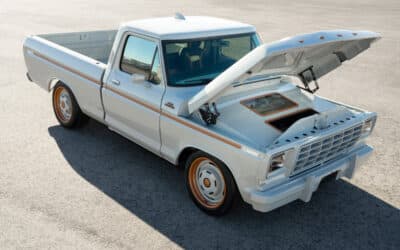Discover the classic trucks that built Ford’s reputation on toughness and reliability. Our rundown of old model Ford trucks takes you from their inception with the Model TT to the F-Series icons that dominated roads and worksites across America.
Whether you’re a history buff, collector, or just appreciate vintage craftsmanship, we’ll cover the era-defining features, evolutions, and highlights that defined the Ford Motor Company and its old truck lineage.
Key Takeaways
- Ford’s entry into the pickup truck market started with the Model TT in 1917, followed by the introduction of the AA and BB models, which marked Ford’s innovation and their commitment to the truck market.
- Vintage F-Series trucks have been a significant part of Ford’s history, evolving through six generations from 1948 to 1979, introducing numerous design changes, technological advancements, and becoming America’s top-selling vehicle series for 39 consecutive years.
- Vintage Ford trucks not only pushed the automotive industry forward but also became ingrained in American culture, appearing in television shows and being owned by celebrities, which cements their role as icons of Vintage Americana.
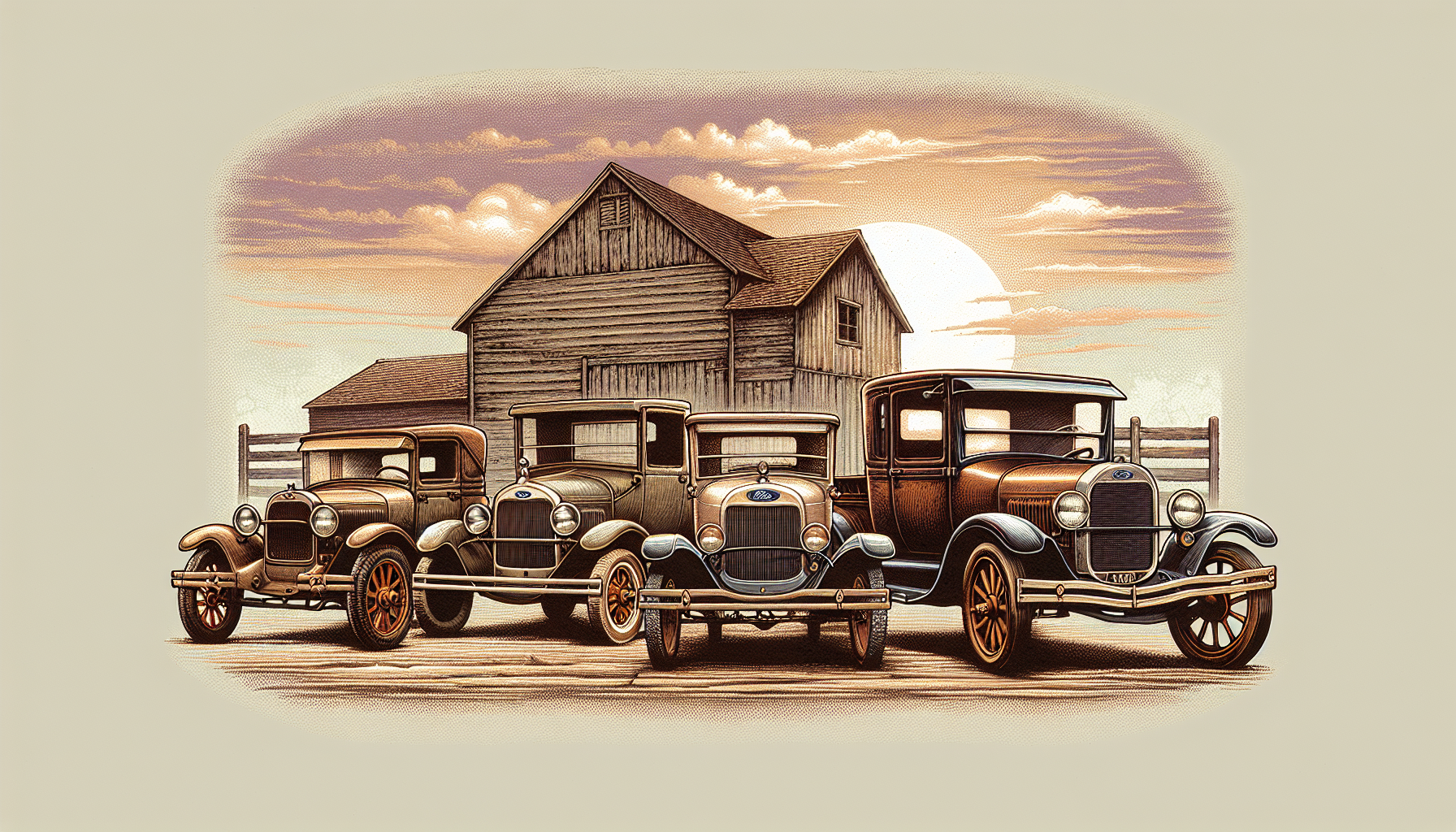
Table of Contents
Ford’s Early Pickup Trucks: Model TT, AA, and BB
Ford’s illustrious truck history began with the unveiling of Model TT, the company’s first foray into the truck market. Released in 1917, this model was specifically designed to cater to the needs of small businesses.
The Model TT paved the way for the Model AA in 1929 and the Model BB in 1933, each model reflecting Ford’s continuous innovation in the truck lineup.
Model TT: The Foundation
The Ford Model TT, marking Ford’s debut into the pickup truck market, revolutionized the industry. Built on a frame capable of handling a one-ton payload, it retained the Model T’s engine and cab, offering a versatile vehicle platform for various trades.
Introduced in 1917, this trailblazing model set the stage for Ford’s coming success in the truck segment.
Model AA and BB: Advancements and Innovations
Capitalizing on the success of the Model TT, Ford launched the Model AA and BB two wheel drive models. The AA, launched in 1929, boasted a larger wheelbase, heavy-duty rear springs, and larger tires to accommodate a 1.5-ton payload capacity. Equipped with a 4-cylinder engine and a 3-speed manual transmission, this model proved Ford’s commitment to innovation and quality.
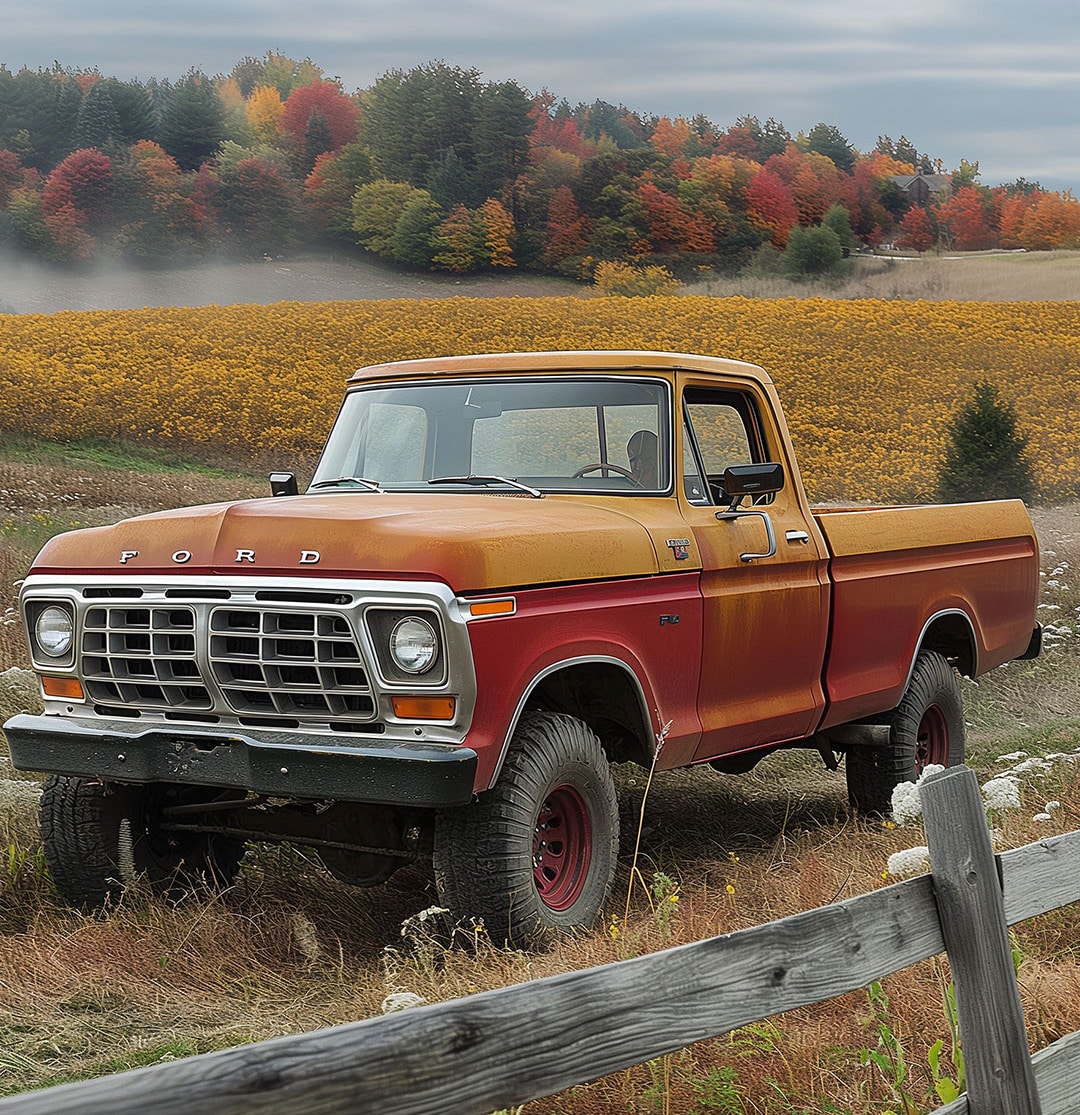
Vintage F-Series Generations: A Closer Look
Progressing from the foundational models, Ford initiated an innovative and design-driven journey with the F-Series. From the first to the sixth generation, each model brought key design changes, engine improvements, and the adoption of four-wheel drive options, all contributing to the F-Series’ impressive record as America’s top-selling vehicle series for 39 consecutive years.
First Generation (1948-1952)
Ford introduced the first-generation F-Series trucks in 1948, embodying their postwar vision of style, comfort, and drivability. The Ford F Series trucks boasted:
- Widened doors
- Improved ventilation and heating
- Redesigned instrumentation
- Adjustable coil-spring bench seat
All contributing to unprecedented comfort for their time.
The production of nearly 346,000 units by 1950 marked the successful dominance in the truck market that Ford produced.
Second Generation (1953-1956)
The second-generation F-Series ushered in an era of upgraded features, including:
- Enhanced suspension and expanded payload capacity, resulting in enhanced steering control
- Transitioning from the Flathead V8 to the more powerful Y-block V8 series, offering more power under the hood
- Multiple displacement options providing up to 300 hp
The introduction of tubeless tires and a 12-volt electrical system further proved Ford’s commitment to innovation and technological advancement.
Third Generation (1957-1960)
With the third-generation F-Series, a significant shift in exterior design was observed, characterized by integrated front fenders and a completely revamped Styleside bed. The introduction of the innovative tilt forward cab C-Series further boosted driver convenience and truck utility, marking Ford’s ongoing commitment to improving user experience within their Ford truck lineup.
Fourth Generation (1961-1966)
The fourth-generation F-Series introduced several significant changes, including:
- A traditional cab and separate bed design
- Optional unibody construction, merging the cab and bed into one cohesive unit
- Twin I-Beam independent front suspension, which improved ride quality and durability
- Expanded engine options to meet consumer and business demands for more power and torque.
Fifth Generation (1967-1972)
The fifth-generation F-Series expanded the range of engine options, incorporating the robust 390 cubic inch V8 engine seen in the 1969 Ford F-250 Camper Special. New trim levels, such as the 1967 Ford F-100 Ranger, offered a fresh and distinctive style, contributing to the versatility of the lineup.
Sixth Generation (1973-1979)
The arrival of the sixth-generation F-Series saw the debut of the F-150 model, rapidly becoming one of Ford’s flagship models. The key features of the sixth-generation F-Series include:
- Double-walled bed construction
- Implementation of front disc brakes
- Use of galvanized steel
- Expanded cabin dimensions
These are very popular years for Ford trucks and are still being bought and sold all the time. If you find one in good shape, you might want to grab it before the price doubles in the next few years or someone else buys them all!
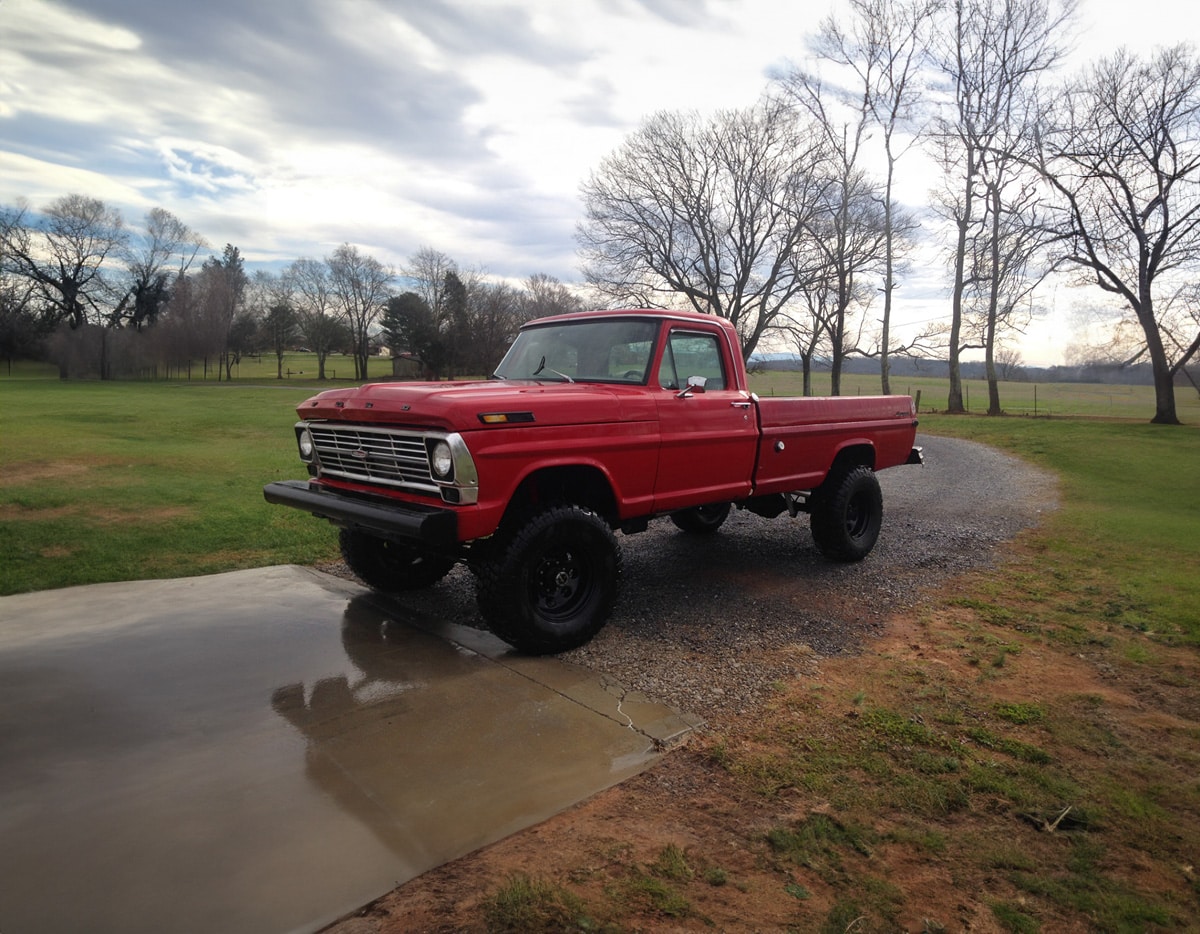
Iconic Vintage Ford Trucks: A Showcase of Classics
From the 1956 F-100 to the 1969 F-250 Camper Special and the 1976 F-150 Ranger XLT, every classic Ford truck tells a unique story of design, craftsmanship, and automotive innovation. These timeless vehicles have not only shaped the automobile industry but have also carved a special place in the heart of American culture, showcasing the rich Ford truck history.
1956 Ford F-100
The 1956 Ford F-100, known for its handsome looks and “new” safety features, quickly became a classic. Despite a decline in pickup sales in 1956, the F-100 held a strong market presence, and its reliability and part availability contributed to its popularity in the collectible market.
1969 Ford F-250 Camper Special
The 1969 Ford F-250 Camper Special, with its distinctive two-tone Harbor Blue over Wimbledon White paint job, is a classic that radiates vintage good looks.
1976 Ford F-150 Ranger XLT
The 1976 Ford F-150 Ranger XLT is a classic that has stood the test of time. Valued for its distinctive design like a two-tone paint scheme, plush interior, and additional chrome trim compared to base models, it is a classic old Ford truck that continues to captivate enthusiasts.
Restoring and Preserving Vintage Ford Trucks
The art of restoring and preserving vintage Ford trucks means you’re going to have to have meticulous attention to detail, knowledge of the vehicle’s history, and a commitment to authenticity (if a original restoration is what you’re going for.)
From sourcing authentic parts to regular maintenance and balancing originality with modernization, every step is crucial in bringing back the glory of these classic machines.
Sourcing Authentic Parts
Acquiring authentic parts is important if you’re trying to preserve the originality of a classic Ford truck. Specialized retailers like Dennis Carpenter and Krawlers Edge, online platforms such as eBay Motors, and salvage yards can be treasure troves of authentic Ford truck parts.
We’re okay with things being modernized. Engines today are much more efficient and you can get much better brakes that you could back then. You can certainly keep that classic look but add in a touch of modern to it and make it easier and more comfortable to drive without sacrificing the “old school cool” vibe these trucks had.
Maintenance Tips
Consistent maintenance is a must-do to make sure that your old Ford truck remains in prime condition. From monthly checks on interior and exterior lights to topping off or changing your fluids like engine oil and engine coolant. This routine maintenance keeps your truck at optimal performance and helps with the longevity of the vehicle.
Balancing Originality and Modernization
Classic Ford truck restorers constantly grapple with the balance between preserving originality and incorporating modernization. I personally don’t mind a touch of modern in my old trucks but I don’t wan’t to lose the feeling I get when I get inside by making it look like a brand new vehicle.
While the use of original parts and components is a great thing to use, making reversible modifications can enhance performance without compromising the vehicle’s original value.
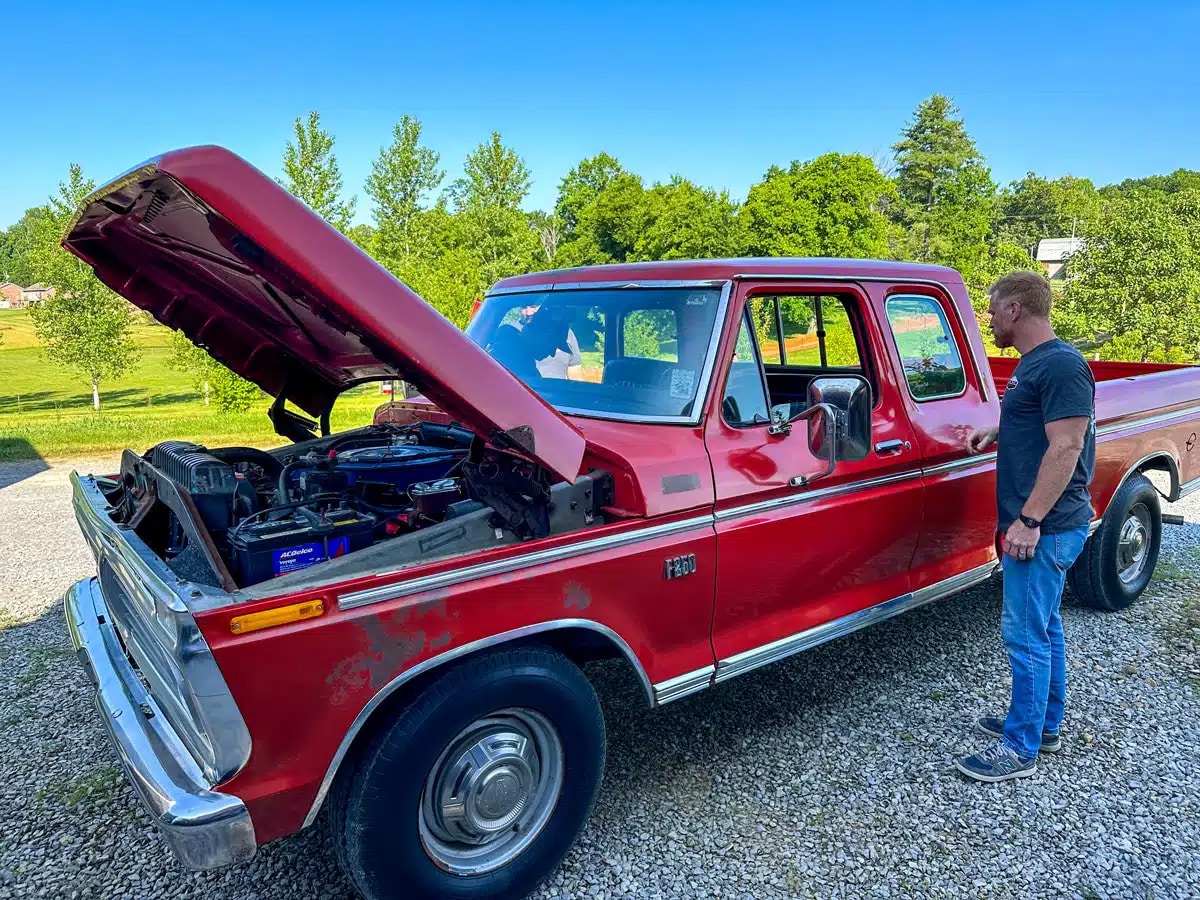
Vintage Ford Trucks in Pop Culture
Vintage Ford trucks have made their mark not only on the roads but also in pop culture. Their design, good looks, and powerful engines have led to a lot of on-screen appearances and celebrity owners, which obviously reinforces their iconic status.
On-Screen Appearances
From the workhorses on “MAS*H” and “Sanford & Son” to the family truck on “The Waltons” and the Old Ford Truck on “The Dukes of Hazzard,” vintage Ford trucks have found a home on the screen. Their on-screen presence shows that these trucks have a lasting appeal to people (just like us!) and iconic status in pop culture.
Celebrity-Owned Classic Ford Trucks
Celebrities such as Deion Sanders, Toby Keith, and Shaquille O’Neal have talked about their love for Ford trucks, showing that they own various models and custom builds. These celebrity-owned classics, each with unique features and characteristics, just make owning a vintage Ford truck that much more impressive.
Summary
From the iconic Model TT to the timeless F-150 Ranger XLT, each vintage Ford truck tells a unique story of innovation, design, and craftsmanship. These vehicles, which have carved a special place in American culture and popular media, continue to inspire with their rugged charm and timeless appeal.
As we at Get Vintage Vehicles appreciate the rich history of vintage Ford trucks, we also look forward to the future, where these classics will undoubtedly continue to inspire, captivate, and endure.
Frequently Asked Questions
What are the names of the old Ford trucks?
The old Ford trucks were designated as Model TT from 1917 to 1928, Model AA from 1929 to 1932, Model BB from 1933 to 1934, the Model 50 in 1935, and the Model 67 in 1936. There was no truck-specific alphanumeric designation from 1937 to 1947.
What are 80s Ford trucks called?
The 80s Ford trucks are called the seventh-generation F-series trucks, known for their focus on aerodynamics and plush interior trappings. These trucks were highly popular during that time period.
What are the names of the Ford truck models?
The Ford truck models include the F-150, F-250, and F-350, with the F-150 being a light-duty, half-ton truck, the F-250 a three-quarter-ton, heavy-duty truck, and the F-350 a one-ton heavy-duty truck.
What was the first Ford truck model?
The first Ford truck model was the Model TT, which was introduced in 1917.
What were some of the significant design changes in the F-Series generations?
Significant design changes in the F-Series generations included improved engines, updated chassis, and the adoption of four-wheel drive options, marking key evolutions from the first to sixth generations.



